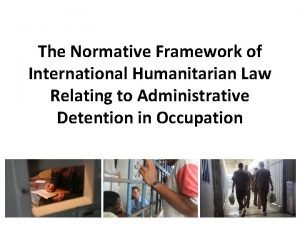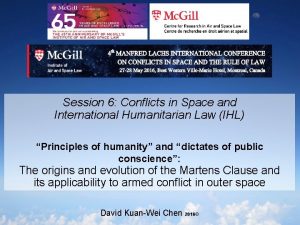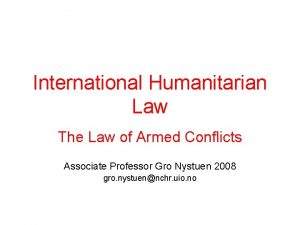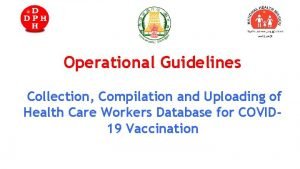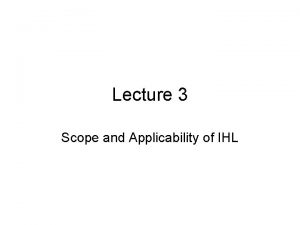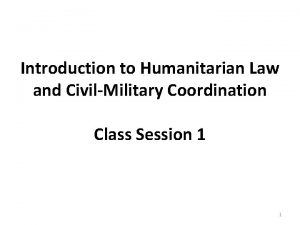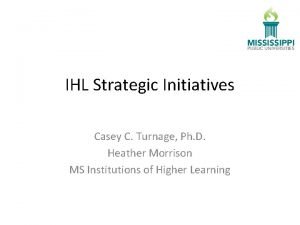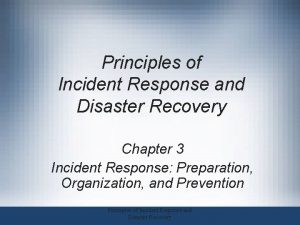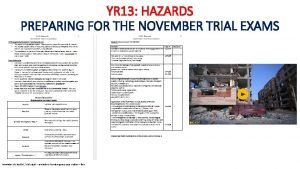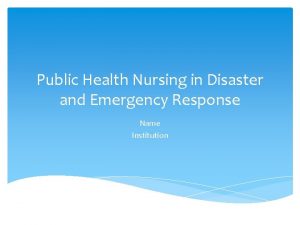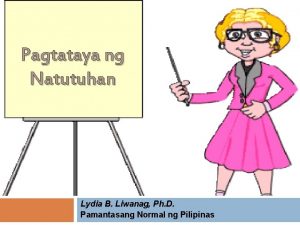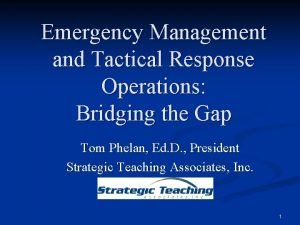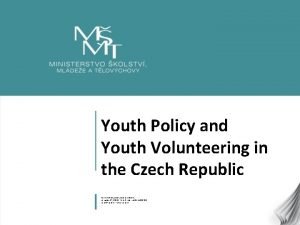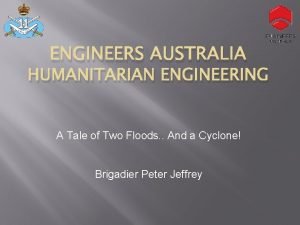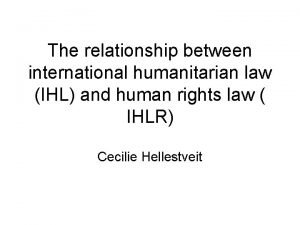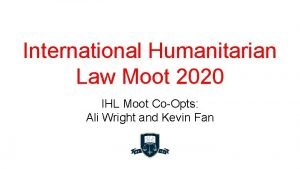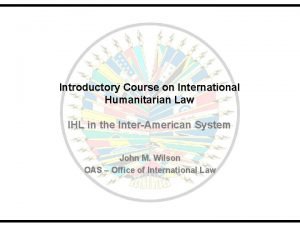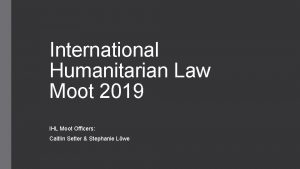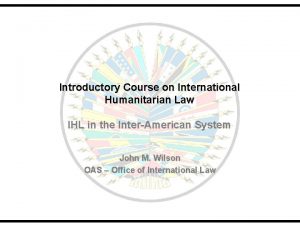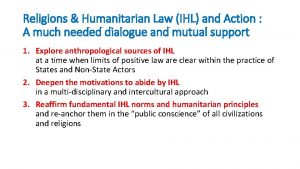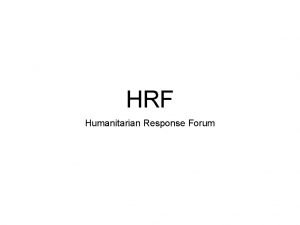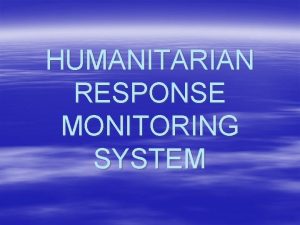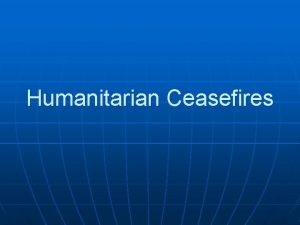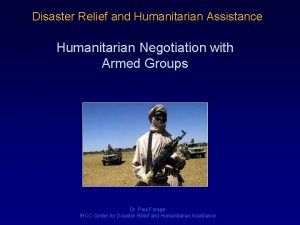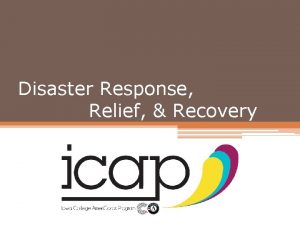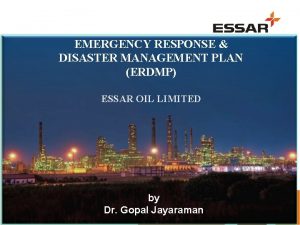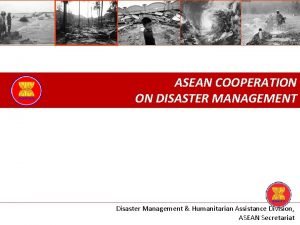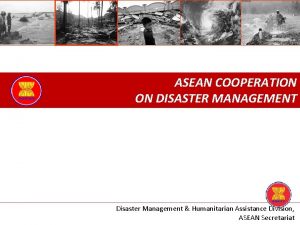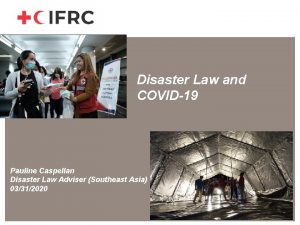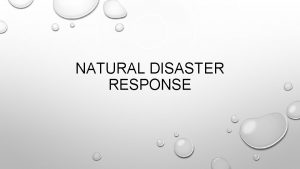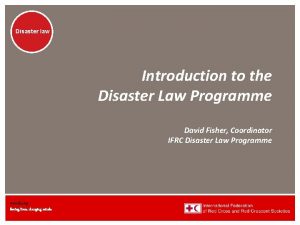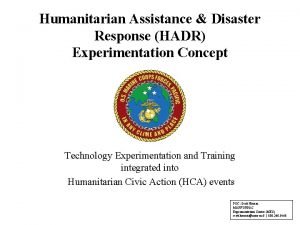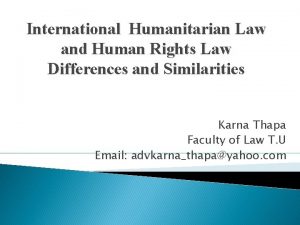International Humanitarian Law IHL and International Disaster Response























- Slides: 23

International Humanitarian Law (IHL) and International Disaster Response Law, Rules and (IDRL) Anne Le. Clerc and Sandra Moretti

Overview of the presentation § Overview of IHL § Overview of IDRL § Main differences § Common considerations § Role of NS for each area of law

What is IHL? INTERNATIONAL HUMANITARIAN LAW § International humanitarian law is a part of public international law § Also known as the "law of armed conflict" or the "law of war" § IHL is set out in treaty form (eg 1949 Geneva Conventions and their Protocols), but additional rules existing in customary international law have been published by the ICRC § Rules which apply only in armed conflict, even if they create obligations in peacetime (eg drafting legislation)

Purpose of IHL Limits in armed conflict LIMIT the suffering caused by armed conflict How does IHL do this? § PROTECTS persons who are not, or no longer, participating in conflict and certain places and objects; § RESTRICTS the means and methods of warfare used by parties to the conflict.

Overview: International Disaster Response Laws, Rules and Principles (IDRL) § Laws and regulations that govern the provision of international assistance in non-conflict disasters. § Has been a focus of IFRC and NS’ since 2001 § Six years of research demonstrated that a lack of legal preparedness hampers international relief § Found that international law on topic exists, but it is dispersed and there are many gaps

The IDRL Guidelines § IDRL Guidelines adopted by consensus by the 30 th International Conference in 2007 § Compile existing international norms and best practice § Recommendations to governments on how to prepare domestic laws and procedures for international assistance § Not a binding treaty

Implementation of the IDRL Guidelines Growing interest in IDRL Guidelines § 20 technical assistance projects (inc Cambodia, Vietnam and Laos) § New domestic laws or rules in 9 countries, draft legislation pending in 12 others § UN and regional resolutions (e. g ASEAN) New tools Model Act on International Disaster Assistance § Disaster law training § Work remaining § More states need to take up the issue

IHL and IDRL: Common Considerations • Both address legal barriers in providing humanitarian assistance: • Administrative bottlenecks • Visas for international relief personnel • Customs and tax duties • Poor quality assistance • Compliance with principles of humanity, neutrality and impartiality

IHL and IDRL: Main differences IHL IDRL Governs armed conflict Relates to international assistance in disasters Consists of a clear set of treaties. No comprehensive legal regime exists for IDRL. International law on topic is dispersed and fragmented. IHL treaties impose binding international obligations on states The IDRL Guidelines are a set of non-binding recommendations to Governments to improve their national laws. IHL specifies special role and access for ICRC and recognizes National Societies While IDRL Guidelines refer to auxiliary role of NS’, they are primarily directed towards the regulation and facilitation of external international actors.

IHL and IDRL: Main differences IHL IDRL Issues of security and access are often more pressing in armed conflict setting, and special rules regarding access of ICRC apply. Security and access are not always major obstacles in disaster settings, international assistance must first be requested or offer accepted by Government. Other authorities/party to conflict besides government may exercise control over certain areas but Domestic authorities will always have the primary coordination role Has a particular focus on protection and diversion of relief goods IDRL Guidelines and the Model Act are more detailed on types of ‘legal facilities’ to be provided to international humanitarian actors, and suggests a pre-registration system.

Role of National Societies in IHL Refer to 31 st International Conference : § Dissemination Resolution 1: Strengthening legal protection for victims of armed conflicts § Dissemination of Resolution 2 : 4 year action plan for the implementation of IHL (pledges, ensure all actors concerned implement). Reminds States of auxiliary role NS. § NS have a mandate to prepare and respond to the needs of those affected by armed conflict and OSV (cf Resol. COD 2011). §

Role of National Societies in IDRL § Disseminate Resolution 7 adopted at the 31 st International Conference § Provide advice and support to their governments to strengthen legal frameworks by undertaking a review against the IDRL Guidelines § Promote the IDRL Guidelines and the Model Act to relevant Public Authorities § Build partnerships

Progress in SEA on IDRL Legal preparedness studies (legislative reviews) undertaken in 2009 in Cambodia, Laos and Vietnam § § A Mekong Regional Forum was held in 2010 to discuss findings § In Cambodia, the draft new law on disaster management has a chapter on international assistance § In Vietnam, VNRC (together with IFRC) has provided comments and suggestions for the draft DM law § An IDRL Impact Study is currently being finalised in Indonesia § Two IDRL workshops (2011 and 2012) held in Philippines and research soon to start § Any others to add? What should be next?

SEA Pledge at the 31 st International Conference 1. Legal preparedness for international disaster response - review existing national regulatory frameworks and support governments to develop legislation, policies and procedures to better facilitate and regulate international disaster assistance Progress? ? 2. Enhancing disaster risk reduction through legislation - review and advise on legal frameworks to empower communities in DRR.

Collaborations with partners in the region on IDRL ASEAN • The ASEAN Agreement on Disaster Management and Emergency Response (and SOPs) incorporates elements of the IDRL Guidelines • AADMER Work plan requires the undertaking of legislative reviews for international assistance • ASEAN Secretariat has shown interest in IDRL • National Societies can offer support to Governments in AADMER implementation and institutionalisation. . Who could champion this?

Sources of IHL § 1859 – Battle of Solferino § 1862 – "A Memory of Solferino" creation of relief societies for the care of the wounded international treaty for the protection of the sick and the wounded on the battlefield

Sources of IHL The Birth of Modern International Humanitarian Law 41863 – Lieber Code 41868 – Declaration of St-Petersburg 41899/1907 – The Hague Conventions

Sources of IHL Geneva Conventions of 1949 4 Wounded and Sick (Land) 4 Wounded, Sick and Shipwrecked (Sea) 4 Prisoners of War 4 Civilian Persons in the Power of the enemy

Sources of IHL Additional Protocols of 1977 4 International Armed Conflicts 4 Internal Armed Conflicts

Sources of IHL Geneva Conventions Ä195 States parties Äuniversal adherence Additional Protocol I Ä172 States Parties Additional Protocol II Ä166 States Parties

Sources of IHL Summary of formal sources of IHL 1864: Geneva Convention (sick and wounded soldiers) 1868: Declaration of Saint-Petersburg (certain ammunition) 1899/1907: The Hague Conventions (laws & customs of war) 1925: Protocol for the Prohibition of the Use of Asphyxiating Gases 1929: Geneva Convention (prisoners of war) 1949: Four Geneva Conventions 1954: Hague Convention on the Protection of Cultural Property (and Protocol) 1972: Biological Weapons Convention 1977: Two Additional Protocols to the GC 1980: Conventional Weapons Convention (and Protocols) 1993: Chemical Weapons Convention 1997: Ottawa Treaty on Anti-personnel landmines 1998: Statute of the International Criminal Court 1999: Second Protocol to the Hague Convention of 1954 2000: Optional Protocol on the Involvement of Children in Armed Conflict 2008 – Convention on Cluster Munitions

Sources of IDRL RC /RC (Soft) Law Global & Regional Institutions Human Rights & Refugee Law Sectoral Law www. ifrc. org Saving lives, changing minds. No Flagship Treaty Regional Law Soft Law Bilateral Agreements

Key Materials for IDRL § Introduction to the IDRL Guidelines § Introduction to IDRL online module: http: //www. ifrc. org/what-wedo/idrl/research-tools-and-publications/idrl-interactive-online-training-module/ § Humanitarian Diplomacy Guidance Note 2: Legislative Issues in Disaster Management and Epidemic Response § 31 st International Conference Background Paper: Progress in the implementation of the IDRL Guidelines § Disasters in Asia: The Case for Legal Preparedness § ‘Law and Legal Issues in Disaster Response: A Desk Study (2007)
 International humanitarian law icrc
International humanitarian law icrc International humanitarian law icrc
International humanitarian law icrc Ihl
Ihl Ee.humanitarian response.info/x/vpdlixjf
Ee.humanitarian response.info/x/vpdlixjf Scope of ihl
Scope of ihl Ihl
Ihl Ihl
Ihl Ihl
Ihl Principles of incident response and disaster recovery
Principles of incident response and disaster recovery Principles of incident response and disaster recovery
Principles of incident response and disaster recovery Newton's first law and second law and third law
Newton's first law and second law and third law Newton's first law and second law and third law
Newton's first law and second law and third law Disaster response curve park model
Disaster response curve park model Park's model disaster response curve
Park's model disaster response curve Role of public health nurse in disaster response
Role of public health nurse in disaster response Rubrics pamantayan sa pagsulat ng tula
Rubrics pamantayan sa pagsulat ng tula Emergency disaster tactical response
Emergency disaster tactical response Humanitarian work psychology
Humanitarian work psychology Humanitarian projects in prague for youth
Humanitarian projects in prague for youth Wcag
Wcag Humanitarian programme cycle 2021
Humanitarian programme cycle 2021 Cadet humanitarian award
Cadet humanitarian award Cadet humanitarian award
Cadet humanitarian award Humanitarian engineers in cape york
Humanitarian engineers in cape york
